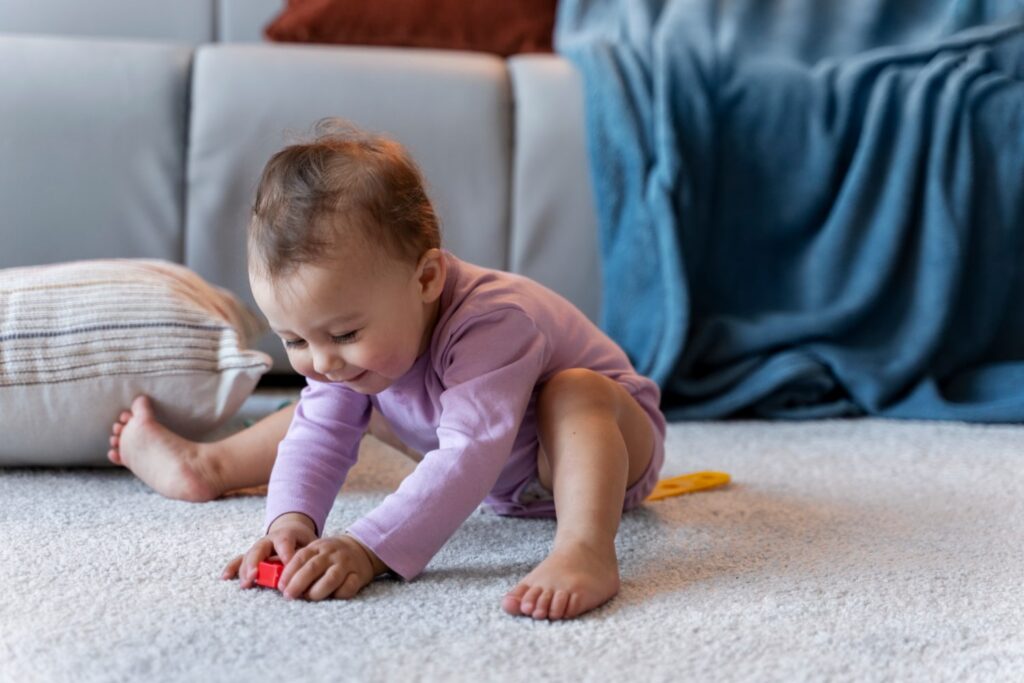
From the moment your newborn takes their first breath, they are greeted by a world that’s vastly different from the cozy, muted environment of the womb. Yet, your baby is not entirely unprepared. While the world outside may be overwhelming at first—with its lights, sounds, smells, and new textures, your baby enters it with a remarkable toolkit: their five senses.
Even before birth, your baby’s newborn sensory development is well underway. These early senses not only help your baby adjust to life outside the womb but also serve as the foundation for learning, bonding, and exploring their new environment.
In this guide, we’ll explore how each of your newborn’s senses develops and functions—and how you, as a parent, can nurture these senses in those precious first months.
1. Touch – The First Language of Love

Touch is the very first sense your baby experiences, both in the womb and after birth. At around 10 weeks of gestation, your baby starts to respond to touch by reaching out to the walls of your womb. By the time they are born, their sense of touch is already well-developed.
Touch plays a crucial role in newborn sensory development, offering a deep sense of comfort and connection. As soon as your baby is placed on your chest after birth, skin-to-skin contact provides warmth, familiarity, and emotional security. Gentle touches, cuddles, and massages can calm your baby, reduce stress hormones, and stimulate brain growth.
How to support touch in newborn sensory development:
- Engage in daily skin-to-skin time.
- Gently massage your baby after bath time.
- Let your baby explore different textures with soft toys and blankets.
2. Sight – A World Slowly Coming Into Focus

At birth, sight is the least developed sense, but it plays a key role in ongoing newborn sensory development. Your newborn can only see clearly up to 20 to 25 centimeters away—just enough to focus on your face during feeding or cuddles.
In the early weeks, babies see mostly in black, white, and gray. But within a few months, their vision sharpens significantly. By 6 weeks, your baby may smile in response to your smile. Around 3 to 4 months, they start tracking movement and recognizing bright colors. By 6 months, their depth perception and ability to detect fine details are much more refined.
How to support sight in newborn sensory development:
- Use high-contrast black-and-white books and toys.
- Make eye contact and smile often.
- Offer bold, colorful toys in your baby’s line of sight.
3. Hearing – Recognizing the Rhythm of the World

Your baby begins to hear sounds around 18 weeks of pregnancy. In the womb, they are comforted by the rhythm of your heartbeat and voice. Once born, your baby’s sense of hearing continues to mature, supporting both emotional bonding and early communication—key parts of newborn sensory development.
Newborns are naturally tuned into voices, especially those they heard during pregnancy. Talking, singing, and reading out loud strengthens the auditory pathways and boosts language development.
How to support hearing in newborn sensory development:
- Speak clearly and often to your baby.
- Sing lullabies and play soothing music.
- Use toys that produce soft sounds or rattles.
4. Smell – Connecting Through Familiar Scents

The sense of smell is highly developed at birth and serves a powerful purpose in newborn sensory development. It helps your baby recognize and bond with you in the early days.
Your newborn can distinguish your natural scent from others almost immediately, especially if you breastfeed. The smell of breast milk and your skin offers a comforting sense of familiarity, grounding your baby during moments of stress or uncertainty.
How to support smell in newborn sensory development:
- Use your own clothing or blanket to comfort your baby.
- Avoid strong perfumes or scents that can confuse their sense of smell.
- Allow close skin contact during feeds.
5. Taste – A Journey That Begins Before Birth

Taste develops early in the womb, influenced by the foods you eat during pregnancy. Your baby becomes familiar with flavors through amniotic fluid, and after birth, continues the journey through breast milk or formula—another essential element in newborn sensory development.
Breast milk carries the flavor of the mother’s diet, helping babies develop taste preferences early on. This exposure can lead to a smoother transition to solid foods later and a more adventurous palate.
How to support taste in newborn sensory development:
- Eat a balanced, varied diet if you’re breastfeeding.
- Offer diverse, natural flavors when introducing solids.
- Avoid sugary or highly processed foods early on.
Final Thoughts: Helping Your Baby Explore the World
Every coo, cuddle, and curious gaze is part of your baby’s journey through newborn sensory development. These early months are filled with rapid growth and endless firsts as your baby uses touch, sight, hearing, smell, and taste to make sense of the world.
By understanding and nurturing your baby’s senses, you’re not only helping them adapt to life outside the womb—you’re laying the foundation for a lifetime of learning, emotional security, and joyful discovery.
So take your time, be present, and enjoy the beautiful process of newborn sensory development, one sense at a time.
Reference :
The World According to Your Newborn – A Full Guide
Also Read :
Baby’s Sense of Touch : How It Develops & Ways to Boost It!
Language Development Activities: 8 Fun Ways to Get Your Baby Talking!




Pingback: Shampoo Pregnancy Test: Does This DIY Method Really Work?